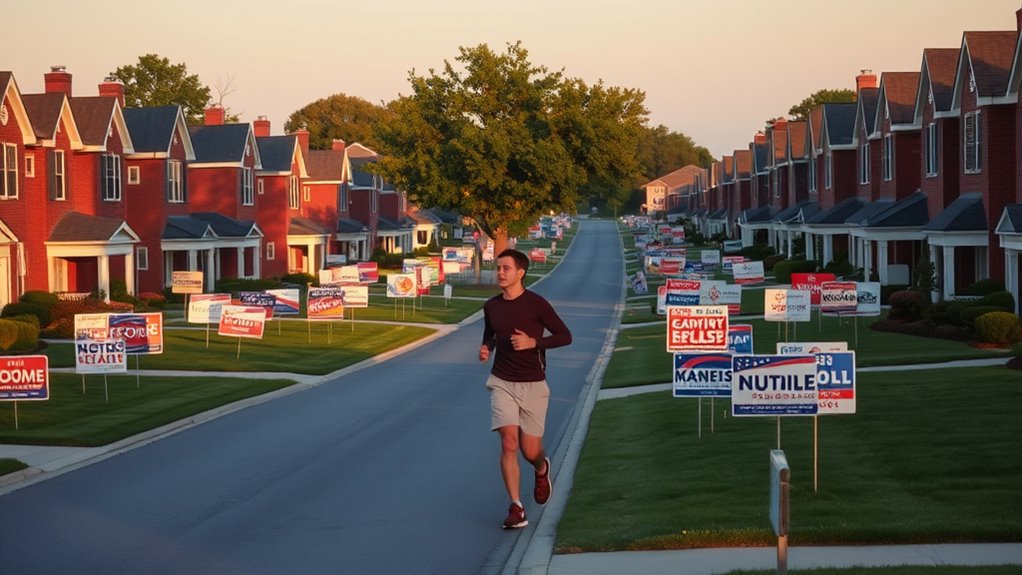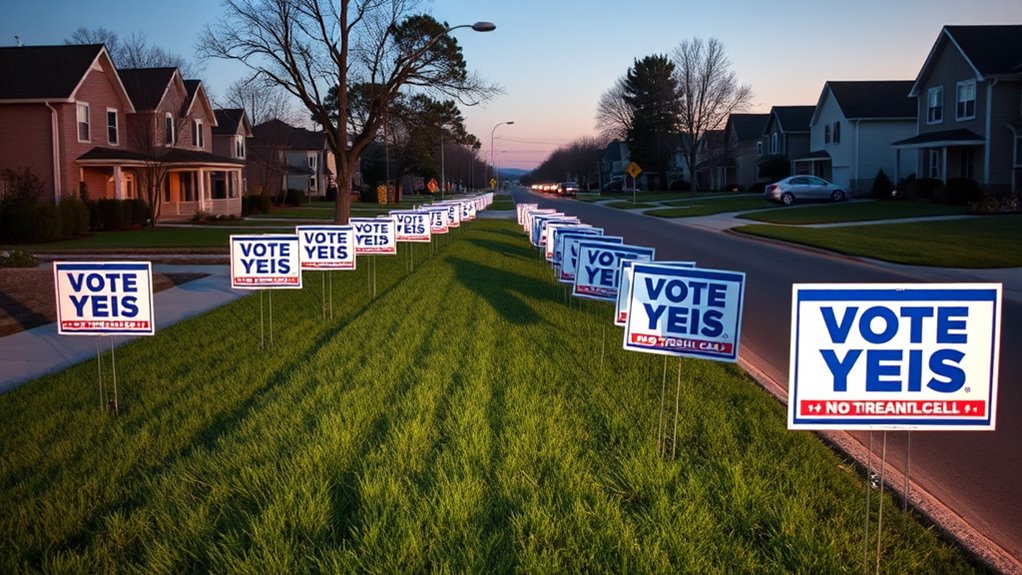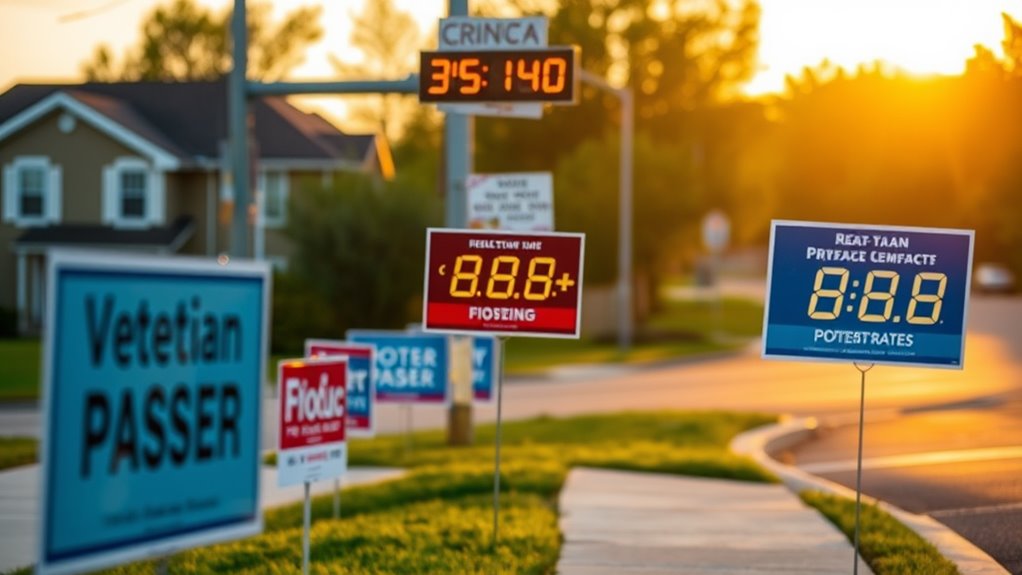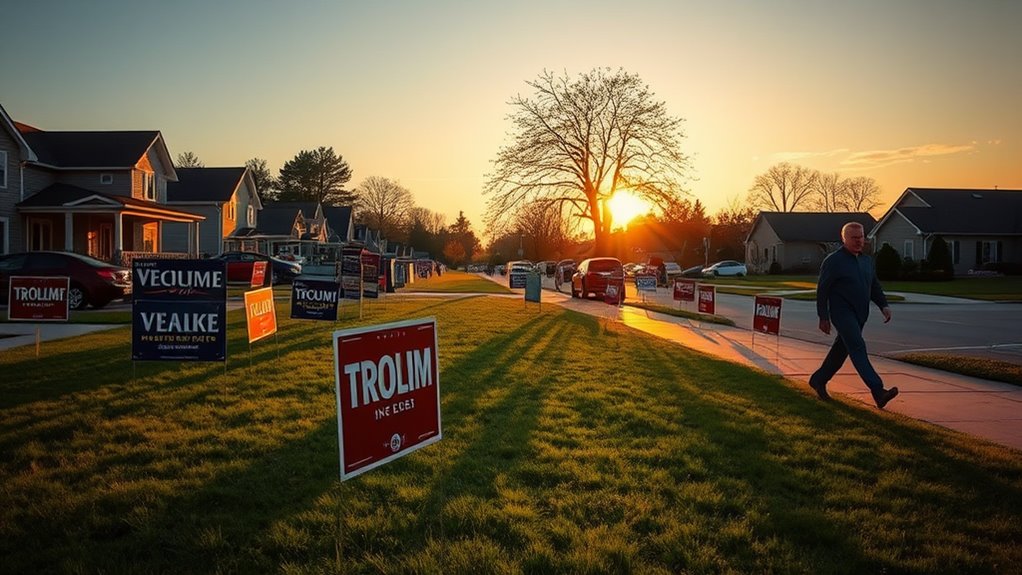Campaign yard signs deliver measurable success in modern political marketing, generating 30,000-70,000 monthly impressions in high-traffic areas. You'll see a 2-4% increase in voter awareness when placing 10-15 signs per block, while each sign influences approximately 37 households within a quarter-mile radius. Research shows that 85% of neighbors notice yard signs within the first week, and repeated exposure increases name recall by 27% among voters. When combined with digital integration through QR codes and social media handles, you're looking at a cost-effective strategy that typically runs $3-8 per unit. These proven metrics reveal just the beginning of yard signs' strategic impact.
Key Takeaway
- Signs in high-traffic areas generate 30,000-70,000 impressions monthly, making them highly effective for brand visibility and awareness.
- Areas with 10-15 signs per block show a 2-4% increase in voter awareness and recognition.
- Each yard sign influences approximately 37 households within a quarter-mile radius through community exposure.
- Extended sign presence increases name recall by 27% among voters in the target area.
- 85% of neighbors notice yard signs within the first week, creating immediate local impact and awareness.
The History of Campaign Signs
Throughout America's political history, campaign yard signs have evolved from simple paper posters to the durable corrugated plastic displays we see today. You'll find that the earliest versions emerged in the 1820s during Andrew Jackson's presidential campaign, where supporters created handwritten signs to show their allegiance.
Key Historical Developments:
- 1840s: The first mass-produced campaign signs appeared during William Henry Harrison's "Log Cabin Campaign"
- 1920s: Introduction of weatherproof materials and professional printing
- 1960s: Plastic materials revolutionized outdoor political advertising
- 1980s: Corrugated plastic became the industry standard
You'll notice that modern yard signs reflect significant technological improvements in both materials and printing methods. When you compare today's signs to their historical counterparts, you'll see dramatic advances in durability, color retention, and weather resistance.
Timeline of Sign Materials:
- Paper and cloth (1820s-1910s)
- Painted wood (1920s-1950s)
- Metal and cardboard (1950s-1970s)
- Plastic and vinyl (1970s-present)
These developments have made campaign signs more cost-effective and environmentally sustainable, while maintaining their essential role in grassroots political messaging.
Cost vs. Impact Analysis
When analyzing campaign yard signs, you'll discover their relatively low cost compared to other marketing tools makes them an attractive option for political campaigns. A typical yard sign costs between $3-8 per unit when ordered in bulk, while television ads can run thousands per minute.
Your campaign's investment in yard signs can yield significant visibility when you consider their longevity and placement potential. Each sign typically remains visible for 30-45 days, generating thousands of impressions at a fraction of a penny per view.
Here's what makes yard signs emotionally compelling:
- You'll create a sense of community momentum when neighbors see multiple signs supporting your cause
- You'll tap into voters' desire to publicly express their values and beliefs
- You'll build trust through consistent visibility in familiar neighborhoods
To maximize your return on investment, you'll need to track placement density and voter response rates. Data shows that areas with 10-15 signs per block demonstrate a 2-4% increase in voter awareness. While yard signs shouldn't be your only campaign strategy, their cost-effectiveness ratio makes them a smart addition to your marketing mix.
Name Recognition Benefits

Building on the cost advantages, yard signs deliver powerful name recognition that compounds over time. You'll find that consistent exposure to your brand through strategically placed signs creates lasting mental imprints in your target audience's minds.
Key Name Recognition Benefits:
- Repeated Visibility: Your signs can generate 30,000-70,000 impressions per month in high-traffic areas
- Geographic Targeting: You'll connect with specific neighborhood demographics that match your ideal customer profile
- Subconscious Impact: Viewers process your message even when they're not actively reading the sign
Maximizing Recognition Value:
- Place signs at major intersections where you'll capture both vehicular and pedestrian traffic
- Rotate locations every 2-3 weeks to reach new audience segments
- Include memorable visual elements that you'll consistently use across campaigns
You'll notice that name recognition builds exponentially when you maintain sign presence for extended periods. Studies show that voters recall candidates' names 27% more accurately when they've seen yard signs versus those who haven't. This same principle applies to your business messaging, making yard signs a reliable tool for establishing lasting brand awareness in your community.
Digital Age Competition
Modern marketing channels might seem to overshadow traditional yard signs, but these physical markers continue to hold unique advantages in the digital age. While you'll find digital ads competing for attention online, yard signs operate in a physical space where they're unavoidable for local traffic.
In today's competitive landscape, you'll need to understand how yard signs complement your digital strategy. Research shows that 68% of consumers make purchasing decisions based on both online and offline touchpoints, making an integrated approach essential.
You'll find yard signs particularly effective when combined with digital elements:
- Your QR code on a yard sign creates an instant bridge between physical and digital worlds, allowing prospects to access your website immediately
- When you include your social media handles, you're extending the sign's reach beyond its physical location
- By incorporating memorable hashtags, you're enabling passersby to join your online conversation
Consider incorporating digital tracking methods to measure your yard signs' effectiveness. You can use unique landing pages or special offer codes that help you monitor how many leads originate from your physical signage, allowing you to optimize your marketing mix accordingly.
Neighborhood Social Influence

As homeowners display yard signs in their neighborhoods, they create a powerful ripple effect of social proof and community influence. When you place a sign in your yard, you're participating in what social scientists call "behavioral contagion," where neighbors often follow suit with similar actions.
Key Influence Factors:
- Visibility creates lasting impressions, with studies showing 85% of neighbors notice yard signs within their first week
- Your sign placement can trigger discussion and informal neighborhood endorsements
- Repeated exposure builds familiarity and trust among community members
How to Maximize Neighborhood Impact:
- Position your sign at ideal viewing angles from both vehicle and pedestrian traffic
- Keep your message consistent with community values and local regulations
- Maintain professional appearance to enhance credibility
You'll find that your yard sign's influence extends beyond immediate neighbors, creating concentric circles of impact throughout your community. Research indicates that each yard sign influences an average of 37 households within a quarter-mile radius, making your message exponentially more effective through social networking and word-of-mouth discussions.
Remember to refresh your sign periodically, as weathered displays can diminish your message's impact and perceived professionalism.
Campaign Resource Management
The successful spread of yard signs through neighborhoods requires careful management of your campaign resources. You'll need to balance your budget, volunteer time, and material distribution to maximize impact while minimizing waste. Planning your sign deployment strategically helps guarantee you're getting the most value from every dollar spent.
Resource Management Priorities:
- You'll want to track your sign inventory meticulously, as 15-20% of signs typically need replacement due to weather damage or vandalism during a campaign
- Your volunteer coordination system should efficiently dispatch teams to high-visibility areas first, maximizing exposure per hour of volunteer time
- You'll need to maintain detailed maps of sign placement to prevent overlap and identify coverage gaps in your target neighborhoods
When you're managing your campaign resources, consider implementing a digital tracking system to monitor sign placement and maintenance needs. You can use specialized campaign software to coordinate volunteer schedules and track your inventory levels. Remember to allocate approximately 7-10% of your total campaign budget for yard signs, including replacement costs and installation materials.
Keep your distribution timeline aligned with local regulations and peak visibility periods to optimize your resource utilization.
Proven Success Metrics

Measuring yard sign campaign effectiveness relies on several proven metrics that demonstrate real impact. You'll want to track these key performance indicators to gauge your yard sign strategy's success:
Geographic Response Metrics:
- Conversion rates within 0.25 miles of sign placement
- Website traffic increases from targeted neighborhoods
- Phone inquiries from specific sign locations
- Social media mentions referencing your yard signs
Visibility and Engagement Data:
- Average daily impressions (calculate using local traffic counts)
- Sign durability and replacement needs
- Public interaction rates (photos, shares, comments)
- Sign placement duration vs. response correlation
Quantifiable Results:
- Lead generation from sign-specific tracking codes
- Cost per acquisition compared to other marketing channels
- Brand recognition uplift in surveyed areas
- Return on investment calculations
You'll find that successful campaigns typically show a 15-30% increase in local awareness and a 5-12% boost in direct inquiries. Track these metrics weekly, and you'll be able to optimize your sign placement strategy based on solid data rather than guesswork. Remember to document weather impacts and seasonal variations for more accurate analysis.
Conclusion
You'll find that yard signs present an ironic paradox in modern campaigning: while their measurable impact remains surprisingly modest, they're still a campaign staple you can't ignore. Though digital marketing's reached unprecedented heights, there's something about those simple plastic signs that continues to influence local elections. Whether you're running for office or supporting a candidate, they're a small but strategic piece in your broader campaign puzzle.









